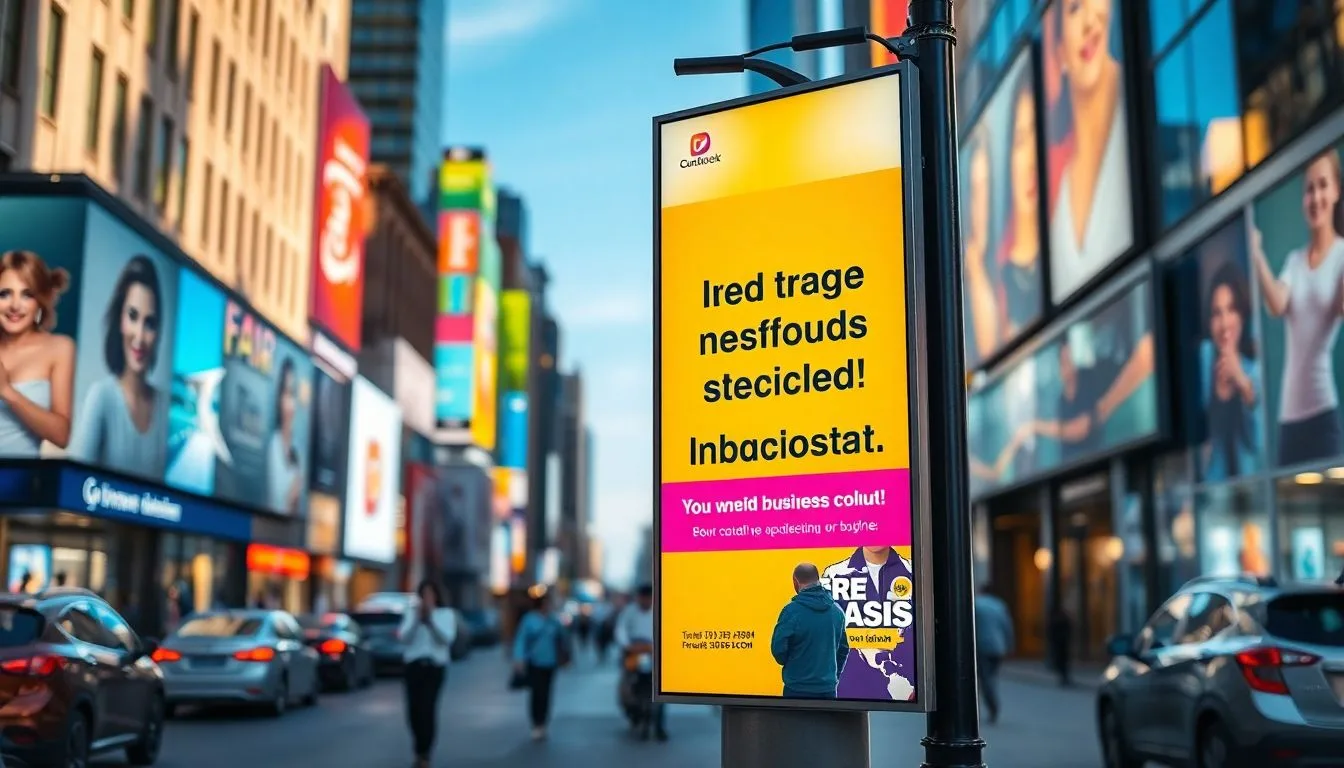Outdoor advertising has a unique power to capture attention. Studies show that about 71% of people notice billboards while driving. This makes it an excellent way to reach potential customers. By utilizing outdoor advertising, businesses can enhance visibility and connect with a broader audience geographically. This article will explore various outdoor advertising channels, crafting effective ads, targeting your audience, measuring success, and planning your budget and campaign.
Choosing the Right Outdoor Advertising Channels
Billboard Advertising
Billboards are one of the most recognizable forms of outdoor advertising. They come in several sizes and formats, including digital options which can change messages throughout the day. Successful billboard campaigns often feature bold visuals and simple messages that resonate with viewers.
- Tips for Location: Choose high-traffic areas where your target audience frequents. Consider visibility from multiple angles.
Street Furniture Advertising
This type includes ads on bus shelters, benches, and kiosks. It offers flexibility and the ability to target local areas. Statistics reveal that street furniture ads can reach over 60% of city residents.
- Selecting Options: Choose placements that match your audience’s habits. For instance, a tech company might benefit from ads in urban centers.
Transit Advertising
Transit advertising encompasses bus wraps, train station posters, and inside transit ads. Real-world examples, like a popular coffee chain’s bus wrap campaign, show an increase in foot traffic by over 30%.
- Impact: This form is effective in building brand awareness among commuters and tourists.
Crafting Compelling Outdoor Ads
Visual Appeal
High-quality visuals capture attention quickly. Research indicates that ads with compelling images can increase engagement by up to 40%.
- Design Tips: Use bright colors and clear images. Keep your design clean to ensure clarity from a distance.
Concise Messaging
Outdoor ads need to be brief and to the point. Effective campaigns often convey messages in seven words or less.
- Creating Memorable Phrases: Use action-oriented language. A strong call to action, like “Visit Us Now,” prompts immediate engagement.
Brand Consistency
Maintaining a consistent brand image is crucial across all marketing channels. Companies like Nike and Coca-Cola have mastered this through cohesive visuals and messaging, creating instant brand recognition.
Targeting Your Audience with Outdoor Advertising
Geographic Targeting
Understanding where your customers are is vital. Placing ads in areas where your audience lives or works maximizes reach and relevance.
- Effective Strategies: Use demographic research to identify ideal locations. For instance, if your target audience is young professionals, target urban centers.
Demographic Targeting
Demographic data, such as age, gender, and income level, can guide your ad placements. Knowing your audience informs better decisions and enhances campaign effectiveness.
- Statistics Insight: Ads targeted at millennials in urban areas can yield higher engagement compared to generic placements.
Psychographic Targeting
Psychographic data encompasses values, interests, and lifestyles. Tailoring your message based on these insights can strike a deeper connection with potential customers.
- Example: A fitness brand promoting healthy living could target ads around gyms or health food stores.
Measuring the Effectiveness of Your Outdoor Advertising
Website Tracking
Website analytics provide insights into how outdoor campaigns affect online engagement.
- Step-by-Step Guide to Implementation:
- Set up UTM parameters for outdoor ads.
- Monitor website traffic and conversion rates.
- Adjust campaigns based on performance data.
Social Media Monitoring
Social media listening tracks how your audience perceives your brand in response to outdoor ads.
- Implementation Tips: Use tools like Hootsuite or Brandwatch to monitor mentions and sentiments around your brand over time.
Surveys and Focus Groups
Gathering feedback directly from your audience offers valuable insights into the effectiveness of your outdoor ads.
- Conducting Surveys: Keep questions simple and focused. Offer incentives for higher response rates.
Budget and Campaign Planning for Outdoor Advertising
Budget Allocation
Effective budget allocation ensures optimal spend across various channels.
- Real-World Strategies: Consider a 60-30-10 split: 60% on dominant channels like billboards, 30% on secondary channels like transit, and 10% for testing new avenues.
Campaign Timing
Aligning your campaign with seasonal events or holidays can significantly boost visibility.
- Successful Examples: Retailers often see a surge during the holiday season, making targeted outdoor ads more impactful.
Choosing the Right Partner
Finding a reliable outdoor advertising agency plays a key role in successful campaigns.
- Tips for Selection: Look for vendors with experience in your industry. Establish clear communication channels for smooth collaboration.
Conclusion
Outdoor advertising offers a powerful way to enhance business visibility. By choosing the right channels, crafting compelling ads, and effectively targeting your audience, businesses can make significant strides in brand awareness. Strategic planning, impactful creativity, and thorough measurement are essential steps to success. Start implementing these strategies now and watch your business visibility grow!


Leave a Reply